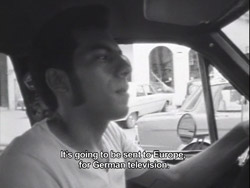Videoarde
The exhibition Videoarde. Critical video in Latin America and the Caribbean belongs to a three-part project Laura Baigorri is developing in Latin America and the Caribbean (2008-2011) with the support of the network of cultural centers of AECID (Spanish Agency for International Cooperation and Development) and Instituto Cervantes.
It consists of the publication of a book, Vídeo en Latinoamérica. Una historia crítica [Video in Latin America. A critical history] (Madrid: Brumaria, 2008), the organization of a series of symposiums under the general title of Expanded Video. New frontiers for the audiovisual in Latin America, and the curatorship of the exhibition Videoarde. Critical video in Latin America and the Caribbean. In addition, some of the exhibited artists held a series of workshops.
Book
The project was born with the publication of the book Vídeo en Latinoamérica, Una historia crítica, in which I participated as the compiler of the texts written by the specialists on Latin American and Caribbean video art. The main aim of the text is to gather together the trajectory of Latin American and Caribbean video under a panoramic and critical perspective, covering its history as well as the most recent experiences. The result is a compilation of essays written by renowned video critics and researchers, specialists in their own countries: Arlindo Machado and Lucas Bambozzi (Brazil), Cecilia Bayá Bolti (Bolivia), Alanna Lockward (the Caribbean), Ernesto Calvo (Central America), Néstor Olhagaray (Chile) Gilles Charalambos (Colombia), Marialina García Ramos and Meykén Barreto (Cuba at present), Maria Belén Moncayo (Ecuador), Raúl Ferrera-Balanquet (US and Canada diaspora), Sarah Minter and Fernando Llanos (Mexico), Fernando Moure (Paraguay), José-Carlos Mariátegui (Peru), Benjamín Villares (Venezuela), Enrique Aguerre (Uruguay) and, of course, our dears Rodrigo Alonso and Graciela Taquini (Argentina), who head these pages.
Exhibition
Videoarde. Critical video in Latin America and the Caribbean. The purpose of this exhibition is to insist on visibility as the only way of resistance; the obstinacy to continue putting under pressure the mainstream media through micro-politics, in this occasion through personal images, ethically and aesthetically elaborated, juxtaposed to the manufactured images ready for a quick and irresponsible consumption. The selection questions us about the effectiveness and the scope of action of critical art, about the author’s ethic responsibility while working in this field, about the subaltern (in)capacity to represent him or herself, about the need of recognition in the works that deal with social and political issues, about the role assumed by Latin American art and artists in the international context, and lastly, about the curator’s legitimacy to undertake his or her work in the transnational context. All the works in Videoarde are inserted on the field of mediation and transformation of the social space, sometimes showing the peculiar ways to confront daily life and some others reflecting upon critical aspects: politics, history/memory, identity, social crisis, violence, machismo, sex, religion, frontier and emigration, urban space and art. The exhibition features 32 videos by artists from Mexico, Nicaragua, Honduras, El Salvador, Panama, Costa Rica, Guatemala, Puerto Rico, Dominican Republic, Cuba, Ecuador, Bolivia, Venezuela, Colombia, Peru, Brazil, Chile, Argentina, Paraguay, Uruguay, US and Spain. The works strike up a dialogue through three different programs: Men, Wolves and Men, Vital Space and My way: Lessons on Local Survival.
Symposium
While the book was launched in the different Centros Culturales de España in Latin America, a series of local symposiums were being held at the same time. Under the general title "Expanded video. New frontiers for the audiovisual in..." different scholars and artists reflected with their colleagues upon different aspects of video art in their countries. The main aim of these encounters was to expose and to analyze the characteristics of contemporary video production in the different areas of Latin America and the Caribbean, posing its relation with the international context and studying the trends and future challenges. They were held on Centros Culturales de España in Montevideo, Buenos Aires, Cordoba, Santiago de Chile (2008), Mexico City (2009), Lima and Asuncion (2010), as well as on Universidad Andina Simón Bolívar of Quito (2009).





Agarrando pueblo. Los vampiros de la miseria (1978) [Catching People. The Vampires of Poverty, 1978], by Luis Ospina and Carlos Mayolo.

Agarrando pueblo. Los vampiros de la miseria (1978) [Catching People. The Vampires of Poverty, 1978], by Luis Ospina and Carlos Mayolo.

Agarrando pueblo. Los vampiros de la miseria (1978) [Catching People. The Vampires of Poverty, 1978], by Luis Ospina and Carlos Mayolo.
